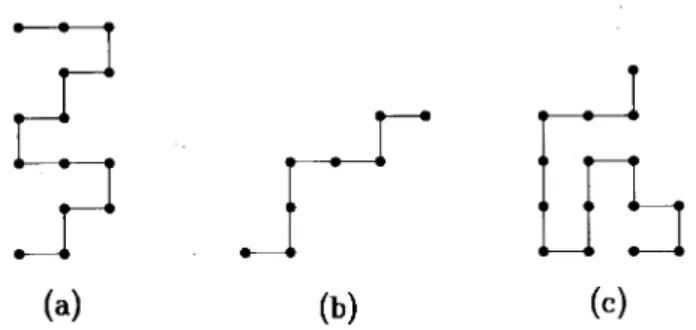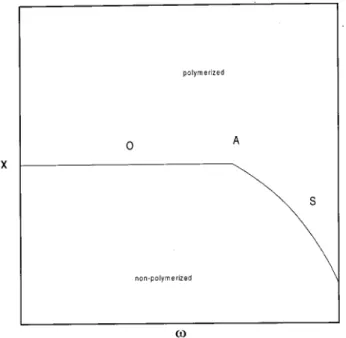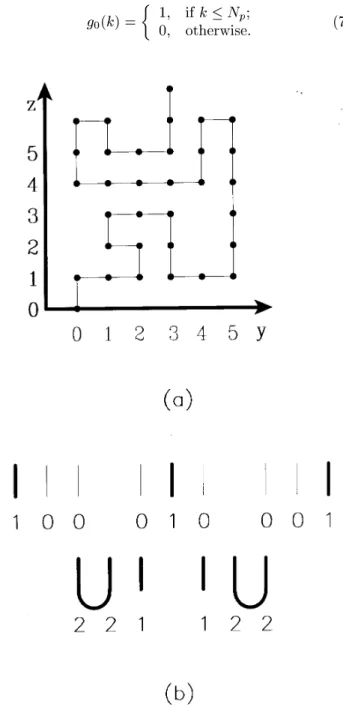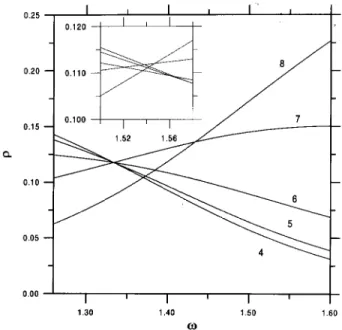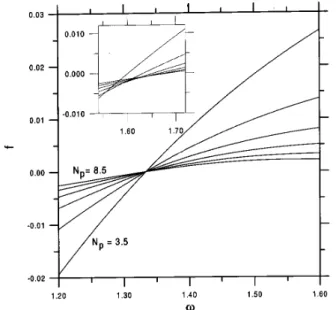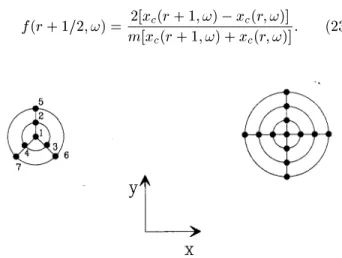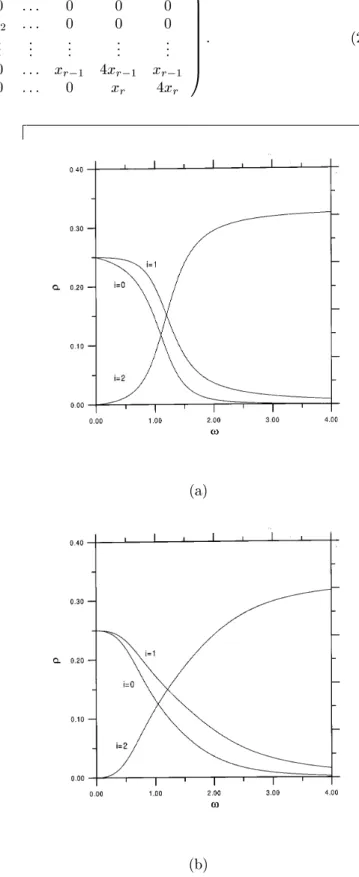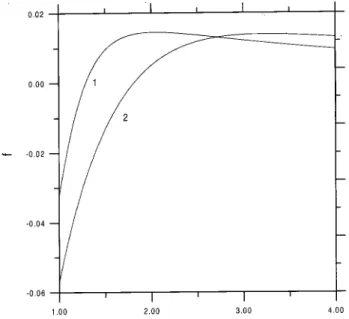Lattice Models for Conned Polymers
J}urgen F. Stilck
Instituto de Fsica Universidade Federal Fluminense
Av. Litor^anea, s/n 24210-340 - Niteroi - RJ, Brazil
Received26October,1998
Self-avoiding chains on regular lattices are frequently used as models to study thermody-namic properties of linear polymers, particularly regarding critical phenomena which may occur in these systems. We review these models, concentrating on their properties under geometric constraints, when the walks are placed inside strips or pores. In these cases the models may be solved using a transfer matrix formalism for the generating functions. A short range interaction between the sites visited by the walks and the walls is included in the model and the distribution of the sites and the forces on the walls are studied as functions of the strength of this interaction.
PACS: 05.50.+q, 61.41.+e
I Introduction
Polymers have attracted much interest for many years, basically because of the huge number of technical ap-plications for them, but also due to some quite funda-mental and challenging problems in the study of sta-tistical mechanical models formulated to address their thermodynamical properties. Some of these models have been proposed and studied quite a long time ago [1], but interest in them was renewed as it was found that the models for polymers may present phase tran-sitions analogous to the ones found in magnetic (and other) systems. Some of the simplest models for linear polymers represent them as self- and mutually-avoiding chains (the constraint takes care of the excluded volume eect), sometimes placed on a regular lattice. It is of interest to consider also other topologies for the poly-mer network [2], but here we will consider only linear chains. The formal equivalence of these models to the n!0 limit of ann-component spin model [3, 4] sheds light on this analogy. It also associates a hamiltonian to the model, since originally the models for polymers are among those models which may be called \geometric", in a sense that a statistical weight is associated to each allowed conguration of the lattice, but no hamiltonian
is explicitly used in this connection. It is worth remark-ing that fornbelow 1 the n-vector model, viewed as a magnetic model, exhibits some anomalies, such as neg-ative susceptibilities, and that some time ago its cor-respondence with polymer models has even be called into question [5], but a careful study of the equation of state in the scaling limit conrms the mapping [6]. Other examples of geometric models are the dimers [7] and percolation [8]. It is remarkable that for those mod-els a correspondence to a hamiltonian model was also found, at least in some particular cases [9, 10].
To study the properties of self-avoiding walks on lattices, one may consider the partition or generating function
Y(x) = X
C N;M
x N
y
M (1)
whereC
interaction needs to be taken into account. Since the number of chains and the number of monomers in the polymeric chain may uctuate, the partition function corresponds to the grand-canonical ensemble. Such a model, as stated above, may be mapped onto a mag-netic n-vector model in the limit n ! 0, the activity of a monomerxbeing equal to the interaction term of the magnetic hamiltonian, while the activity y which controls the number of chains is proportional to the magnetic eld term [11]. As usual for magnetic sys-tems, in the limity!0 the model undergoes a second order phase transition at a critical activityxcin two or more dimensions. Unlike to what happens in the Ising model, in one dimension the model exhibits a rst or-der transition at xc= 1 [12]. The critical properties of the model, such as the critical activity and exponents, have been extensively studied by many techniques. In two dimensions, very precise results are known through transfer matrix calculations [13] and principally series expansions [14]. Also, the exact values of some criti-cal exponents are known exactly in this case [15]. In the dilute limit, when interchain contacts may be ne-glected, one may consider the case of a single chain (m= 1 in Eq. 1). The problem of calculating the par-tition function, even in this particular case and on a two-dimensional lattice, has not been solved so far and there are indications that, if a exact solution might be found, it will not belong to the class ofD,finite func-tions, which encompasses all exact solutions known so far for statistical mechanical models [16].
The self avoidance constraint is the origin of the diculty of solving the counting problems for chains on a lattice. If this constraint is relaxed (this is fre-quently called the ideal chain approximation), most of the calculations may be done analytically, but they re-sult in classical critical exponents [4]. It is possible to take the excluded volume interactions into account par-tially, such as counting only chains without immediate returns. These calculations, although leading to bet-ter numerical values for non-universal paramebet-ters such as critical activities, also result in classical exponents, as expected. These \beyond mean eld" approxima-tions turn out to be equivalent to exact soluapproxima-tions of the models on treelike lattices, such as the Bethe and Husimi lattices [17]. Another simplied version of the walk counting problem are the so calleddirectedwalks,
where it is assumed that in one or more axes of the lat-tice only steps in thepositive direction are allowed [18]. Many analytical calculations are possible in such mod-els, but again the correct critical exponents are missed. In Fig. 1 examples of some of the walks described above are depicted.
Figure 1. Examples of walks on the square lattice: (a) Par-tially directed walk, with positive steps only in the vertical direction; (b) Fully directed walk, with positive steps only in both directions; (c) Self-avoiding walk.
More recently, the behavior of polymers in the pres-ence of a surface was studied [19], as was also done for other systems exhibiting critical phenomena [20]. An appropriate model for this problem consists in consid-ering an additional Boltzmann factor!=e,for each monomer on the surface, so that <0 (! >1) would correspond to an attracting surface. The partition func-tion for this model is
Y(x;!) =X
CN;Nwx
N!Nw; (2)
[12, 22]. One possibility in this case would be that the adsorption transition corresponds to a tricritical point. This model and others related to it were much studied by several techniques such as scaling and Monte Carlo simulations [23], transfer matrix and nite size scaling methods [24] and series expansions [25].
Figure 2. Phase diagram for a polymer in the presence of a surface. The activity of a monomer is denoted byxand a short range interaction energyfor monomers located on the surface is included, so that!=e
,. O is the ordinary (bulk) polymerization transition, S is the surface polymer-ization transition and A is the adsorption multicritical point (also called special transition). A is located atx=xc (the bulk critical polymerization activity) and!=!0>1.
The study of polymers in the presence of a surface leads naturally to the consideration of other geometric constraints, such as wedges and slabs [26]. In this paper we will review some recent work on the thermodynamic behavior of self-avoiding chain under a one dimensional constraint, such as a strip or a pore. In these cases the solution of the problem may be found through a recursive procedure for the generating functions of the model. In Section II we dene the model and show the combination of transfer matrix and generating function formalisms which lead to its solution. The results for walks conned in strips are shown in Section III and some new results for walks in pores may be found in Section IV. Final comments and conclusions are in Sec-tion V. The spatial distribuSec-tion of monomers and the tension on the walls for walks conned in a strip were already discussed before [27, 28].
II Denition of the model and its
solution
We will consider self-avoiding chains which are conned in structures which are innite in one direction (let us call itz) and nite in the direction(s) perpendicular to z. Two specic examples will be dealed with: a) A strip on the square lattice of nite width in one direction and innite length, and b) A pore, with a nite crossection. Other geometries may also be considered, provided the number of lattice sites in the hyperplanes orthogonal to z is nite. If the sets of sites in each hyperplane are identical to each other, with respect to number and connectivity, as is the case in the examples above, the method of solution is simpler and we will consider this case from now on, assumingNp sites in each of them. In general, we will allow the statistical weight of each monomer to be site-dependent, that is, its value will depend on the localization in the hyperplane of the site the monomer occupies. Thus there may be up to Np dierent activitiesxi, but in general we will be inter-ested in more symmetric models and this number is reduced. The choice of dierent weights enables us to nd the spacial distribution of monomers in the sys-tem and also to take into account interactions between the monomers and the walls, so that, for instance, a monomer which is located at the walls may have a dif-ferent statistical weight than a monomer which is not. In order to take into account the excluded volume con-straint, we follow the procedure proposed by Derrida [13] and specify, at each hyperplane, the connectivity properties of all bonds of the chain arriving from lower values of z. This may be done specifying the bond belonging to the segment of the chain which includes the initial monomer (placed at z = 0) and the pairs of bonds connected to each other by a segment whose monomers are all at lower values ofz. In Fig. 3 these denitions are shown through examples. The congu-rations of the hyperplanes are represented by a set of integer numbers associated to each of the Np sites. A site with no bond incident from below is associated to 0, the only site connected to the initial monomer cor-responds to 1 and the pairs of sites connected to each other are designated by the same number larger than 1, dierent for each pair. The maximum number of possible congurations of a hyperplane is given by [29]
Nc;max=
N p
+1 2
X
i=0
where Ji(Np) is the number of congurations with i pairs, which is equal to
Ji(Np) =
Np!
i!(i+ 1)!(Np,2i,1)!
: (4)
Actually some congurations do not occur due to boundary conditions and the self-avoidance constraint. For example, a conguration such as (2;1;2) is forbid-den for chains in a strip forbid-dened on the square lattice with a crossection ofNp= 3 sites and limited by walls impenetrable to the monomers. Also, the number of non-equivalent congurations is usually smaller due to the symmetry of the hyperplanes in each case. For ex-ample, for the strip withNp= 3 the number of allowed congurations isNc= 5 (Nc;max= 6 in this case), but due to the reection symmetry this number will be re-duced to Ns = 3, as is shown in Fig. 3. In any case, Nsincreases very fast withNp, and this sets a limit to the sizes of the crossections we are able to consider.
The partition function for conned self-avoiding chains may be calculated through a combination of the transfer matrix [13] and the generating function [18] for-malisms. In order to obtain the partition function of an ensemble of conned self-avoiding chains, we rst nd the Nc allowed hyperplane congurations. Next, we dene partial partition functions gz(k), which encom-pass the contributions of all monomers located belowz and of chains which arrive atz in thek'th hyperplane conguration. Therefore
gz(k) =
XN
a Y
i=1 [x
N(i)
i ]; (5) whereNa is the number of dierent site dependent ac-tivitiesxi andN(i) is the number of monomers located below z of each walk considered in the sum. We thus have a set ofNc partition functions, and may consider the addition of an additional hyperplane to the walks included in gz(k). Since they all arrive at the hyper-plane located atz in thek'th conguration, the parti-tion funcparti-tionsgz
+1are related linearly to the gz gz
+1( i) =
Nc X
j=1
A(i;j)gz(j): (6) The elements of the transfer matrixA(i;j) are the con-tributions to the partition function of the monomers placed on the Np sites located in the hyperplane atz. If congurationjmay not be followed by conguration i, A(i;j) is set equal to zero. In general, the elements of the transfer matrix are polynomials in the activities
xi;i= 1;Na, one monomial for each possibility of hav-ing congurations i and j connected. We will choose the initial monomer of the walks to be placed at the hyperplane z= 0. If we now order the Nc hyperplane congurations in such a way that the rst Np corre-spond to having just one bond arriving at one site from below, such as the rst three congurations in Fig. 3, we will have
g 0(
k) =
1; ifkNp; 0; otherwise.
(7)
Figure 3. (a) - Self-avoiding walk conned in a strip with N
p = 6. The walk arrives at the line located at
Considering now the ensemble of all the walks which end at any value ofzin hyperplane congurationk, its partition function will be
G(k) = 1 X
z=1 g
z(
k): (8)
From the recursion relations for the partial partition functions, Equations 6, and the initial conditions on the walks which lead to Equations 7, we nd that the partition functionsG(k) are the solutions of a set ofN
c linear equations
Nc X
j=1
[A(i;j), i;j]
G(j) =,g 0(
i); (9)
where
i;jis the Kronecker delta. Calling B
ithe matri-ces obtained if we replace thei'th column of the matrix A!A
I by the vector ,g
0, the solution of these linear equations may be written as
G(i) = jB
i j jA,Ij
; (10)
whereIis the identity matrix. Thus, the determination of the partition functions is reduced to the calculation of determinants. In general, due to the particular sym-metry of the specic problem considered, the partition
functionsG(i) will be equal for all hyperplane congu-rations related by symmetry. Thus, the actual size of the determinants we need to calculate in Equation 10 is reduced fromN
c to N
s.
In general, we will be interested in a particular sub-set of the chains included in all the partition functions G(i). For example, we might consider all chains which end at one of the rst N
p hyperplane congurations. The appropriate partition function will be
G= N
p X
i=1
G(i): (11)
The thermodynamic properties of the model may then be obtained from the partition function. For example, the mean number of the number of monomers with ac-tivityx
i in the chains will be
hN i i= x i G @G @x i ; (12)
and the mean number of monomers in the walk is
hNi= N a X i=1 <N i
>: (13)
Now expressions 10 and 11 for the partition function may be used and lead to
c
hNi= N a X j=1 x j 1 P Np i=1 jB i j @ P Np i=1 jB i j @x j , 1 jA,Ij
@jA,Ij @x
j !
: (14)
d At the polymerization transition the mean number of monomers diverges. In all particular cases we consid-ered this divergence originates from the second term in Equation 14, so that jA,Ij!0 is the critical condi-tion. As expected, this condition is identical to the one obtained by considering a single chain using the usual transfer matrix formalism [13], which corresponds to having the largest eigenvalue of the transfer matrix A equal to 1. In our calculation, although an ensemble of chains is considered, the thermodynamic properties at the critical condition are dominated by the contri-butions of innite chains at the polymerization transi-tion. Another point to be stressed is that at the poly-merization transition all thermodynamic properties are
determined by the transfer matrixA, the contributions coming from the determinantsjB
i
jvanish. This is phys-ically very reasonable, since we would not expect that the initial and nal conditions imposed on the walks, which are reected injB
i
j, would have any inuence on the transition. One quantity we consider is the fraction of monomers with a particular activityx
i, which is
i= hN i i hNi : (15)
At the critical condition, this density is equal to
Finally, the tension or pressure applied by the chains on the walls which limit the strip or the pore may be cal-culated considering the change of the thermodynamic potential
=, ln(G)
(17) as the walls are moved. This quantity diverges at the transition, so that the tension or pressure per monomer is the quantity to be looked at.
To do the calculations, we rst generate all hyper-plane congurations. Next, the transfer matrix is built, taking into account the symmetry of the model. These two rst steps are done through computer programs with just logical and integer variables, the elements of the transfer matrix, which in general are polynomials in the activities, are calculated exactly. Finally, the trans-fer matrix is used as input for the numerical calculation of the thermodynamic properties of the model.
III Results for chains in strips
A particular realization of the calculations described above may be done for walks conned in strips dened on the square lattice. For a square lattice in the (y;z) plane, a strip with N
p sites in the crossection is de-ned by all lattice sites with 0 y N
p
,1. This problem was already studied in detail for ideal chains [30], and it is interesting to nd out what inuence the self-avoidance constraint has on the results. A short range interaction between the monomers and the im-penetrable walls located at y = 0 and y = N
p ,1 is included, so that a monomer located at the walls con-tributes with an additional Boltzmann factor!=e
, to the partition function.
Due to the reection symmetry of the model with respect to a line at y = (N
p
,1)=2, we start den-ing [(N
p+ 1)
=2] activities, so that pairs of sites in the crossection which are equidistant of the center of the strip have the same activity. Without much compu-tational eort, it was possible to study widths up to N
p= 9 ( N
c = 1353 and N
s= 681 in this case). As an example, we give the transfer matrix for a strip with N
p= 3, with the crossection congurations ordered as in Fig. 3,
A= 0 B B B B @ x 1 x 1 x 2 x 2 1 x 2 0 x 2 1 x 2 x 1 x 2 x 2 x 1 x
2 0 0
x 2 1 x 2 x 1 x 2 x 1 x 2 1 x 2 0 x 2 1 x
2 0 0
x 2 1 x
2 0
0 0 x
2 1 x 2 0 x 2 1 x 2 1 C C C C A ; (18)
where monomers in the center and on the walls have activitiesx
1 and x
2, respectively.
In this model, we studied the fractionof monomers in each column y and the tension on the walls at the transition activity x
c for xed values of
!. The criti-cal activity is a decreasing function of!for xed width N
p. At low values of
!it decreases withN
p, whereas at higher ! an increase withN
p is obtained. The curves x
c(
!) cross the two-dimensional (N p
! 1) value for x
c roughly between 1.65 and 1.75. For ideal chains, the results are qualitatively similar, but all curves with N
p
2 cross the two-dimensional critical activity value x
c= 1
=4 at!= 4=3, which is the adsorption transition value for this case. For self-avoiding chains the adsorp-tion transiadsorp-tion is estimated to occur at!
0= 1
:820:03 [25], above the values in whichx
c( !;N
p) cross the two-dimensional critical activity. AsN
p is increased, these crossing values increase also, approaching!
0.
Figure 4. Fractions of monomers(y) located at columny forNp= 9 as functions of!. The main graph shows results for ideal chains and in the inset data for SAW's are shown. The curves are foryranging from 4 to 8, as indicated.
The densities(y) show a concave prole for neutral walls ! = 1, with a maximum density in the center of the strip. This is expected since the central region is favored entropically. As ! is increased, monomers on the walls decrease the energy of the system and thus the prole becomes convex. In Fig. 4 the densities are plotted as functions of ! for a strip with N
p = 9. Due to the reection symmetry,(y) =(N
p
(1 y 7)is found when ! is equal to the adsorp-tion value !
0 = 4
=3, but the crossing pattern of the curves obtained for self-avoiding chains is more com-plex, as may be seen in the inset, and the prole in this case is convex at the estimated adsorption value for self-avoiding chains on the square lattice.
The force on the walls may be obtained through the procedure indicated above if we imagine the operation of increasing the spacing between the walls. If the lat-tice parameter is equal toa, we have
F = 1 a
@
@y
(19) where a attractive force is positive. As stated above, this force diverges at the polymerization transition, so that we consider an adimensional force per monomer, dened asf =
aF
hNi, which may be calculated through
f = 1 x
c
@x c @N
p
!
(20) Since we know the critical activities for integer values of the wall separationN
p only, we evaluate the derivative through a discrete approximation and thus
f(N p+ 1
=2;!) = 2[ x
c( N
p+ 1 ;!),x
c( N
p ;!)] x
c( N
p+ 1 ;!) +x
c( N
p ;!)
: (21) For ideal chains, the curvesf!may be seen in Fig. 5 for wall separation between 2.5 and 7.5. ForN
p 2:5 the force is repulsive for ! <!
0 = 4
=3 and attractive for ! above the adsorption value. For N
p = 1 :5 the ! independent value f = ,2=5 is found. Thus, for !>4=3, a stable equilibrium point is found at low val-ues of wall separation, an unstable equilibrium point being located at innite separation. For ! below the adsorption value the force is always repulsive and the equilibrium point at innite separation becomes stable. For self-avoiding chains, the situation changes qualita-tively. The force vanishes atN
pdependent values of !, all below the estimated adsorption value for this case, as may be seen in the inset of Fig. 5. This leads, for ! > 1:549375:::, besides the stable equilibrium point at low wall separation, to a new unstable equilibrium point at a nite value of N
p which grows as
! is in-creased. The equilibrium point at innite separation is always stable. In Fig. 6 a curve f N
p for self-avoiding chains is shown, illustrating the behavior de-scribed above. Thus, for self-avoiding chains, the rather unphysical behavior found for ideal chains, which show an attractive force between the walls for large distance
above the adsorption transition, does not occur. More details about the behavior of chains in strips may be found in references [27] and [28].
Figure 5. Force on the walls as functions of!for ideal chains for values ofNp between 3.5 and 8.5. In the inset, results for self-avoiding chains and the same range forNpclose to f = 0 are displayed showing that, unlike to what happens for ideal chains, the force vanishes for dierent values of! for eachNp.
Figure 6. Force on the walls as functions of the wall separa-tionNp,1 for self-avoiding chains and!= 1:64. The circles indicate the calculated values and the lines are just guides to the eye. In the inset, the region close to the unstable equilibrium point is enlarged.
IV Results for chains in pores
self-avoiding chains in pores, with a nite crossection com-prising Np sites and innite length in the z
direc-tion. Dierent crossections may be considered, such as squares and rectangles. To illustrate this, we will dis-cuss here the problem of cylindrical pores, discretized so that the sites other than the central one are dened at r possible distances of the center and in m dier-ent directions, as may be seen in Fig. 7. In general, the number of sites in the crossection for a cylindrical pore dened as above will be Np = 1 +mr. This is
rather unphysical for large values ofr, since we would expect Np to grow with r2. We number the sites se-quentially in a way illustrated in Fig. 7. Due to the
Cmsymmetry of the problem, we dener+1 activities
xi, i= 0;1;:::;r, for a monomer placed at distance i
from the center. The force on the walls applied at each of themsites located on them will be
F = 1ma@ @r ; (22)
where a is the distance between two successive radii. Again we use a discrete approximation for the deriva-tive and evaluate the adimensional force per monomer
aF
hNi, at the critical condition, which is given by f(r+ 1=2;!) = 2[xc(r+ 1;!),xc(r;!)]
m[xc(r+ 1;!) +xc(r;!)]: (23)
Figure 7. Two examples of crossections for cylindrical pores: (a) r = 2, m = 3, with the sequential numbering of sites shown; (b)r= 3,m= 4.
We will briey show how the properties of ideal chains conned in the pores dened above may be stud-ied. For this we dene a set ofr+ 1 partial partition functionsgl(i);i= 0;1;:::;r. Ingl(i) the contributions
of all chains withlsteps (l,1 monomers) whose nal monomer is located at a distanceiof the center of the pore are included. It is then easy to write done the recursion relations for the gl(i), which are
c
gl+1(0) =x0[2gl(0) +mgl(1)]; gl+1(i) =xi[4gl(i) +gl(i+ 1) +gl(i
,1)];i= 1;2;:::;r,1; (24) gl+1(r) =xr[4gl(r) +gl(r
,1)]: If the initial monomer is placed at the center of the pore, we have
g0i=x0i;0: (25)
As usual, we may dene the partition functions
G(i) = 1 X
l=0
gl(i); (26)
which are the solution of a set ofr+ 1 linear equations
r+1 X
j=1
[A(i;j),i;j]G(j) =,g
0(i): (27)
A= 0
B B B B B B B @
2x0
,1 mx
0 0 0 ::: 0 0 0
x1 4x1 x1 0 ::: 0 0 0
0 x2 4x2 x2 ::: 0 0 0
... ... ... ... ... ... ... ...
0 0 0 0 ::: xr,1 4xr,1 xr,1
0 0 0 0 ::: 0 xr 4xr
1
C C C C C C C A
: (28)
d Due to the band structure of the matrix some proper-ties of the model may be calculated analytically [30].
To study the properties of self-avoiding chains in the pores, we generated the crossection congurations and the polynomials which are the elements of the transfer matrix. As an example, we show some re-sults for m= 3. Since at each additional value of the radius r the number of sites in the crossection is in-creased bym, the number of crossection congurations grows very fast withr, limiting the cases we could con-sider. Forr= 1;2;3 we found Nc= 16;532;26200 and Ns= 5;108;4530, respectively. So, we limited ourselves to a maximum valuer= 2. As in the cases of chains in strips, some possible congurations are not connected to any other in the transfer matrix and therefore may be eliminated. But, unlike to what happens for chains in strips, these congurations are not obviousapriori, so we detected them after the transfer matrix was ob-tained. Such congurations do not occur forr= 1 and for r = 2 their elimination reducedNc to 531 and Ns to 105.
In Fig. 8 the densities for ideal and self-avoiding chains in the pore are shown for r = 2 andm = 3 as functions of !. Although dierences are apparent be-tween both cases, they are relatively smaller than the ones observed in the case of chains in strips. This is expected since the coordination numbers of the sites in the pores are larger than the ones of the corresponding sites in the strips, and thus the self avoidance constraint is expected to have a smaller inuence on the results for chains in pores. Finally, Fig. 9 displays the results ob-tained for the force on the walls forr= 2;m= 3. Again we notice that, similar to what was found for the strips, the force vanishes at a lower value of! for ideal chains than it does for self-avoiding chains.
(a)
(b)
Figure 9. Force on the wall for cylindrical pores withr= 2 andm= 3. Curve 1 corresponds to ideal and curve 2 to self avoiding chains.
V Discussion and nal
com-ments
We studied the properties of ideal and self-avoiding chains in strips and pores, concentrating on the spa-tial distribution of monomers and on the tension on the walls. It should be stressed that the solution of statistical mechanical models in conned geometries, particularly on strips or on the surface of cylinders, is not new. The main interest in such studies is to use -nite size scaling in order to provide information on the behavior of the two-dimensional models from the solu-tion of a sequence of one-dimensional models [31]. Also, scaling arguments have been applied very successfully to conned polymers [32], but it should be noticed that these arguments usually lead to monotonical behavior of the thermodynamic properties with the size of the system. Our results show their most interesting fea-tures at sizes below the ones where nite size scaling is valid. This is clear if we consider the tension on the walls of the strips, which display equilibrium points at low values ofN
p.
To our knowledge, there are no experimental results regarding the distribution of monomers for chains con-ned in pores or strips. The tension on plates with poly-mers in solution has been measured [33], being repulsive at low plate separation with a weak attractive tail as the
separation increases, in qualitative agreement with the results for ideal chains. So, at least within the precision of the measurements, no unstable equilibrium point was found. Oscillating forces have also been reported [34], but only for monodisperse melts with rather low num-bers of monomers (N equal to 20 and 65), and thus no comparison can be made with the present calculations. In principle, it would be possible to study the behavior of monodisperse melts with techniques similar to the ones used above, but with a transfer matrix which will grow very fast with the number of monomers.
Acknowledgments
We acknowledge partial nancial support by the Brazilian agencies FINEP and CNPq, as well as a crit-ical reading of the manuscript by Kleber D. Machado.
References
[1] P. J. Flory, Principles of Polymer Chemistry, Cornell University Press (1953).
[2] B. Duplantier, J. Stat. Phys.54, 581 (1989) [3] P.-G. de Gennes, Phys. Lett. A38, 339 (1972) [4] P.-G. de Gennes,Scaling Concepts in Polymer Physics,
third printing, Cornell University Press (1988). [5] P. Gujrati, Phys. Rev. B31, 4375 (1985); Phys. Rev.
Lett.55, 1161 (1985).
[6] J. C. Wheeler, J. F. Stilck, R. G. Petschek and P. Pfeuty, Phys. Rev. B35, 284 (1987).
[7] J. F. Nagle, C. S. O. Yokoi, and S. M. Bhattacharjee inPhase Transitions and Critical Phenomena, vol. 13, ed. by C. Domb and J. L. Lebowitz, Academic Press (1989).
[8] D. Stauer, Phys. Repts.54, 1 (1979).
[9] P. W. Kasteleyn and C. M. Fortuin, J. Phys. Soc. Japan Suppl.26,11 (1969), and Physica57, 536 (1974). See also J. W. Essam in Phase Transitions and Critical Phenomena, vol 2, ed. by C. Domb and M. S. Green, Academic Press (1972).
[10] H. N. V. Temperley and M. E. Fisher, Phil. Mag. 6, 1061 (1961); P. W. Kasteleyn, Physica27, 1209 (1961) and J. Math. Phys.4, 287 (1963).
[11] J. C. Wheeler, S. Kennedy and P. Pfeuty, Phys. Rev. Lett. 45, 1748 (1980); J. C. Wheeler and P. Pfeuty, Phys. Rev A24, 1050 (1981).
[12] P. M. Pfeuty and J. C. Wheeler, Phys. Rev. A27, 2178 (1983).
[13] B. Derrida, J. Phys. A14, L5 (1981).
[15] B. Nienhuis, Phys. Rev. Lett.49, 1062 (1982); see also B. Nienhuis inPhase Transitions and Critical Phenom-ena, vol 11, ed. by C. Domb and J. L. Lebowitz, Aca-demic Press (1987).
[16] A. J. Guttmann and I. G. Enting, Phys. Rev. Lett.76, 344 (1996).
[17] J. F. Stilck and J. C. Wheeler, J. Stat. Phys. 46, 1 (1987); J. Stilck and M. J. de Oliveira, Phys. Rev. A 42, 5955 (1990); E. Botelho and J. F. Stilck, Phys. Rev. E48, 723 (1993).
[18] V. Privman and N. M. Svarkic,Direct Models for Poly-mers, Interfaces and Clusters: Scaling and Finite Size Properties, Lecture Notes in Physics, Springer, Berlin (1989).
[19] K. De'Bell and T. Lookman, Rev. Mod. Phys. 65, 87 (1993).
[20] K. Binder in Phase Transitions and Critical Phenom-ena, vol. 8, ed. by C. Domb and J. L. Lebowitz, Aca-demic Press (1983).
[21] R. J. Rubin, J. Chem. Phys.43, 2392 (1965).
[22] P. Serra and J. F. Stilck, Europhys. Lett. 17, 423 (1992); Phys. Rev. E49, 1336 (1994).
[23] E. Eisenriegler, K. Kremer and K. Binder, J. Chem. Phys. 77, 6286 (1982); E. Eiseriegler, J. Chem. Phys. 79, 1052 (1983).
[24] I. Guim and T. Burkhardt, J. Phys. Am22, 1131 (1989).
[25] D. Zhao, T. Lookman and K. De'Bell, Phys. Rev. A 42, 4591 (1990).
[26] J. M. Hammersley and S. G. Whittington, J. Phys. A 18, 101 (1985); S. G. Whittington and C. E. Soteros, Israel J. of Chem.31, 127 (1991).
[27] J. F. Stilck, Europhys. Lett.40, 19 (1997); Physica A 257, 233 (1998).
[28] J. F. Stilck and K. D. Machado, Eur. Phys. J., accepted (1998).
[29] P. Serra, doctoral thesis (USP - Brazil) (1991). [30] E. A. DiMarzio and R. J. Rubin, J. Chem. Phys.55,
4318 (1971).
[31] M. N. Barber inPhase Transitions and Critical Phe-nomena, vol. 8, ed. by C. Domb and J. L. Lebowitz, Academic Press (1983).
[32] V. Privman, Phys. Rev. B32, 520 (1985).
[33] K. Ingersent, J. Klein, and P. Pinkus, Macromolecules 19, 1374 (1986).
